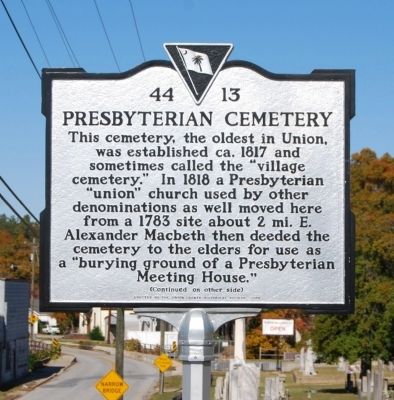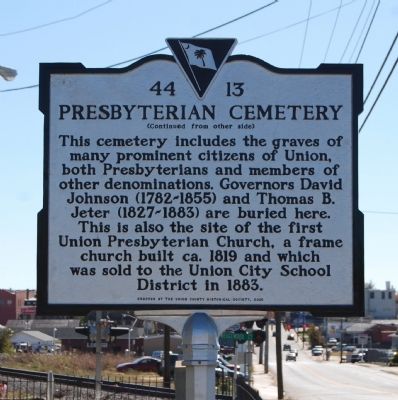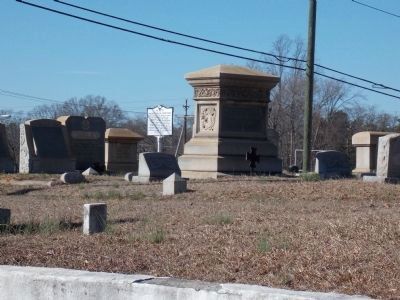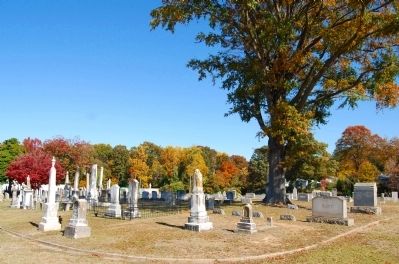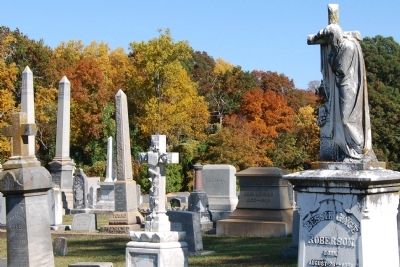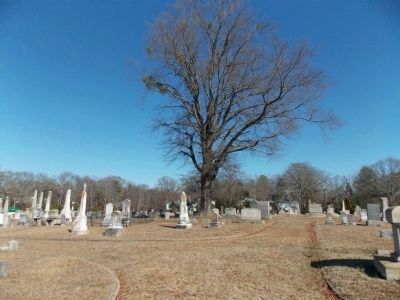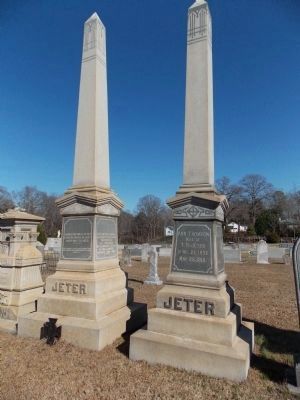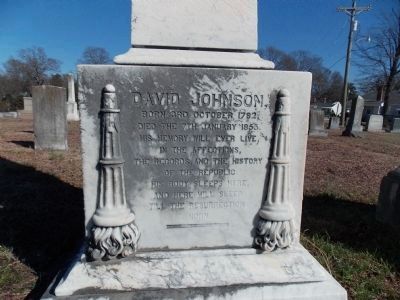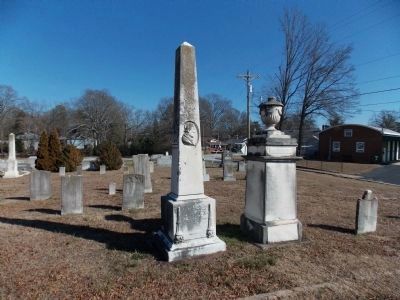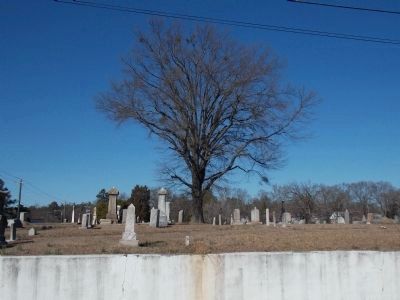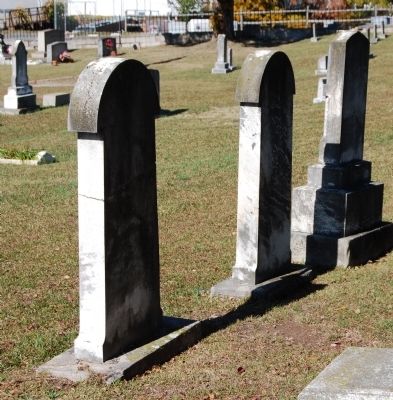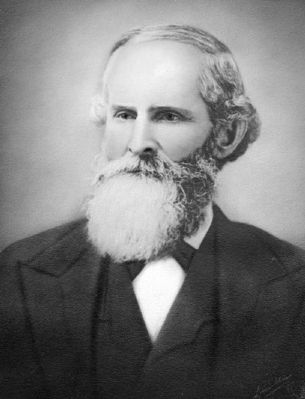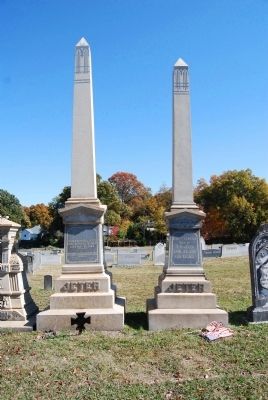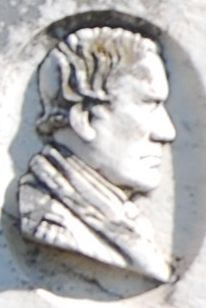Union in Union County, South Carolina — The American South (South Atlantic)
Presbyterian Cemetery
[Front]:
This cemetery, the oldest in Union, was established ca. 1817 and sometimes called the "village cemetery." In 1818 a Presbyterian "union" church used by other denominations as well moved here from a 1783 site about 2 mi. E. Alexander Macbeth then deeded the cemetery to the elders for use as a "burying ground of a Presbyterian Meeting House."
[Reverse]:
This cemetery includes the graves of many prominent citizens of Union, both Presbyterian and members of other denominations. Governors David Johnson (1782-1855) and Thomas B. Jeter (1827-1883) are buried here. This is also the site of the first Union Presbyterian Church, a frame church built ca. 1819 and which was sold to the Union City School District in 1883.
Erected 2006 by Union County Historical Society. (Marker Number 44-13.)
Topics and series. This historical marker is listed in these topic lists: Cemeteries & Burial Sites • Churches & Religion • Government & Politics • Settlements & Settlers. In addition, it is included in the South Carolina, Union County Historical Society series list. A significant historical year for this entry is 1817.
Location. 34° 43.15′ N, 81° 37.45′ W. Marker is in Union, South Carolina, in Union County. Marker is on North Pinckney Street, on the right when traveling north. Marker is located near the southwest corner of the cemetery, at the intersection of North Pinckney Street and Wallace Court. Touch for map. Marker is in this post office area: Union SC 29379, United States of America. Touch for directions.
Other nearby markers. At least 8 other markers are within walking distance of this marker. Culp-Beaty Hall (about 700 feet away, measured in a direct line); Union Mill (approx. ¼ mile away); Thomas N. Dawkins House (approx. ¼ mile away); Union County Revolutionary War (approx. ¼ mile away); Union County Confederate Monument (approx. 0.3 miles away); Union County Jail (approx. 0.3 miles away); Union County Lynchings of 1871 (approx. 0.3 miles away); John Pratt (approx. 0.3 miles away). Touch for a list and map of all markers in Union.
Also see . . .
1. Thomas Bothwell Jeter. Thomas Bothwell Jeter (October 13, 1827 – May 20, 1883) was Democratic Governor of South Carolina from September 1, 1880 to November 30, 1880. (Submitted on November 12, 2008, by Brian Scott of Anderson, South Carolina.)
2. Governor Thomas B. Jeter House, 203 Thompson Blvd., Union. This finely crafted house was constructed by Thomas Bothwell Jeter, a man prominent in Union County and South Carolina affairs. (Submitted on November 12, 2008, by Brian Scott of Anderson, South Carolina.)
3. David Johnson. David Johnson (October 3, 1782 – January 7, 1855) was an antebellum Democratic Governor of South Carolina from 1846 to 1848. (Submitted on November 12, 2008, by Brian Scott of Anderson, South Carolina.)
4. South Carolina Governor David Johnson. David Johnson was born in Louisa County, Virginia. (Submitted on November 12, 2008, by Brian Scott of Anderson, South Carolina.)
Additional commentary.
1. About Thomas Bothwell Jeter
Jeter was governor of the state for only three months (September 1, 1880 – November 30, 1880), making his administration the shortest in South Carolina history. Jeter became governor by default. Lieutenant Governor William Dunlap Simpson became governor following Governor Wade Hampton's resignation in 1879. This made Jeter the next in line of succession, due to his office being President Pro Tempore of the South Carolina Senate. In 1880, William Dunlap Simpson resigned after being appointed Chief Justice of the State Supreme Court. This caused Jeter to be raised to the governors office, where he served for three months. He did not seek election.
— Submitted August 21, 2009, by Brian Scott of Anderson, South Carolina.
2. About David Johnson
In 1846, David Johnson, one of the judges of the superior courts of the state, an eminent lawyer of the upper country, was elected governor of the state. His administration was marked by the formation of the Palmetto regiment, and by its achievements in the war with Mexico. This noble regiment consisted of between eleven and twelve hundred men, mostly young men, the average age of the members not exceeding twenty-three. They were chiefly of the native population, and of good families — no mercenaries seeking pay and plunder, but ardent young volunteers, eager for distinction in war, and chivalrously seeking glory near the flashing of the guns.
The regiment distinguished itself, second to none, in most of the affairs which marked the march from Vera Cruz to the conquest of the capital of Mexico. They won credit at the siege of Vera Cruz ; suffered terribly on the march to Alvarado; were put in charge of Puebla; were in the several battles of Contreras, Churubusco, Chapultepec, and at the gates of the city; and it was the flag of the regiment that first waved over the walls of the conquered city of the Montezumas. But the regiment suffered, among the worst, in all these actions. Colonel Butler, its commander, was slain at its head while leading the charge. Lieutenant-Colonel Dickinson, succeeding lo the command, perished shortly after in Jike manner; but their followers gallantly avenged them. The remnant of the regiment returning to Carolina, covered with bloody laurels, scarcely numbered three hundred men. The state awarded a medal to each of the survivors. (Source: The History of South Carolina from its First European Discovery to its Erection Into a Republic by William Gilmore Simms (1890), pgs 429-430.)
— Submitted August 21, 2009, by Brian Scott of Anderson, South Carolina.
3. Additional information on the Palmetto Regiment Monument (see photo #16).
From "South Carolina: A guide to the Palmetto State" by the Federal Writer's Project, 1941 the following is more detailed information about the Palmetto Regiment Monument and its history. See the associated marker for the monument as it exists currently.
“Guarding the portico, west, is a life-sized iron Palmetto Tree, a monument to the famous Palmetto Regiment of South Carolina in the Mexican War. Designed by Christopher Werner of Charleston, and scarcely distinguishable from a living tree, its pedestal bears plates engraved with the names of about 450 regiment members who died in the service; only some 300 of the 1,200 members survived. Sherman’s men destroyed the original plates; they were replaced by Matt Heffler, whose father helped to cast the original monument. Broken into bits by a freak tornado of February 1939, the statue has been restored.”
— Submitted March 23, 2015, by J. Makali Bruton of Accra, Ghana.
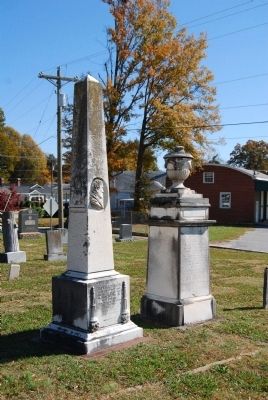
Photographed By Brian Scott, November 8, 2008
15. Tombstones for
Governor David and Mrs. Johnson
Governor David and Mrs. Johnson
Died the 7th January 1855.
His memory will ever live,
in the affections,
the records, and the history
of the Republic.
His body sleeps here,
and here will sleep
till the resurrection
morn.
He loved his country,
his whole country.
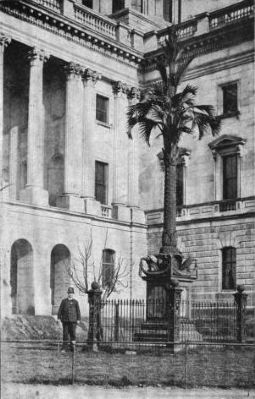
The History of South Carolina from its First European Discovery... by William Gilmore Simms, circa 1855
16. South Carolina Mexican War Monument
Erected in honor of the nearly 300 survivors of the Mexican War from the Palmetto Regiment. The monument, located on the state house grounds, was destroyed by Sherman when he burned Columbia.
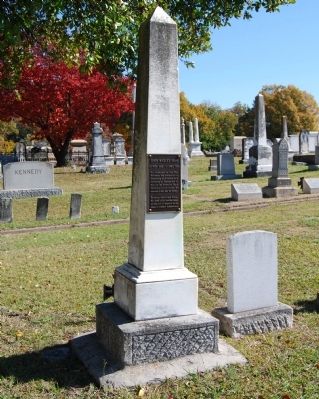
Photographed By Brian Scott, November 8, 2008
17. Tombstone for John Wesley Cross
24 Nov. 1826 - 5 April 1866
He engaged in the War Between the States at the beginning and served with distinction as Captain and Lt. Col. of the Palmetto Sharp Shooters to the close. He survived it but was its victim.
Patriotic, dutiful and brave. His death added another name to the roll of martyrs in the cause of southern independence.
Credits. This page was last revised on June 16, 2016. It was originally submitted on November 12, 2008, by Brian Scott of Anderson, South Carolina. This page has been viewed 2,016 times since then and 30 times this year. Last updated on March 23, 2015, by J. Makali Bruton of Accra, Ghana. Photos: 1, 2. submitted on November 12, 2008, by Brian Scott of Anderson, South Carolina. 3. submitted on February 11, 2013, by Stanley and Terrie Howard of Greer, South Carolina. 4, 5. submitted on November 12, 2008, by Brian Scott of Anderson, South Carolina. 6, 7, 8, 9, 10. submitted on February 11, 2013, by Stanley and Terrie Howard of Greer, South Carolina. 11, 12, 13. submitted on November 12, 2008, by Brian Scott of Anderson, South Carolina. 14. submitted on March 10, 2009, by Brian Scott of Anderson, South Carolina. 15. submitted on November 12, 2008, by Brian Scott of Anderson, South Carolina. 16. submitted on August 21, 2009, by Brian Scott of Anderson, South Carolina. 17. submitted on November 12, 2008, by Brian Scott of Anderson, South Carolina. • Bill Pfingsten was the editor who published this page.
